by Dr Katsuyuki Miyasaka
The description of the history of Japanese pediatric critical care starts with the history of modern Japanese anesthesia, which was brought to Japan by an American missionary medical group in 1950, 5 years after the war. There was not a single physician trained in anesthesiology in Japan before then.
The mission brought several outstanding textbooks of anesthesiology with them, when personal possession of medical textbooks was a luxury. One of these textbooks was Leigh and Belton’s Pediatric Anesthesia (Macmillan Co., New York, New York). Awoken by this book, Dr. Seizo Iwai who was a young surgeon then, decided to study under Dr. Leigh and he eventually did so for 2 years at LA Children’s Hospital. He returned to Japan in 1961. Dr. Hiroshi Sankawa succeeded him, studying there for 3 years, then joining in 1965 Japan’s first children’s hospital, the newly opened National Children’s Hospital (NCH). Dr. Iwai took the position of the Chief of Anesthesia.
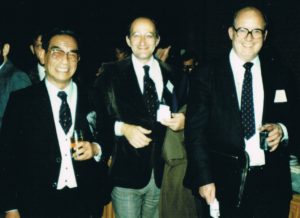
The late Dr S. Iwai (left) and Drs DJ Steward, AW Conn 1972 in Kyoto
Both Drs. Iwai and Sankawa were stimulated in many ways in LA, but were especially affected by the respiratory care of infants. They were involved in the development of the J circuit for infants in the Bird ventilator, the use of capnometers, and the clinical application of the Astrup blood gas measurement device, all of which are still under development and useful today.
The anesthesia department with its 5 full time staff lead by Dr. Iwai covered all the anesthesia cases in the OR. Although they did not have a unit, they provided respiratory care for cases outside of the OR on a 24/7 basis, fostering a tradition of anesthesiologists taking care of every critically ill child in the hospital. This was in 1965, a year after the Tokyo Olympics, when such services were unheard of even in adult hospitals. This tradition became the fundamental style of Japanese pediatric anesthesia.
In 1972, when the 5th WCA was held in Kyoto, Japan, Profs. S. Iwai, H. Sankawa, M. Satoyoshi, G. Suzuki, T. Fujiwara, Y. Kawashima, and K. Tamiya inaugurated the Japanese Society of Pediatric Anesthesia (JSPA). Several distinguished professors from around the world were invited, including Profs. A.W. Conn and D.J. Steward from HSC, and J. Storks from Melbourne. The theme of the first meeting was “Respiratory care of neonatal respiratory distress syndrome” and it became customary to include topics on caring for critically ill children. JSPA held 60 meetings until 1995 when it grew into a more anesthesiology oriented national organization.
In 1973, Dr. Kats Miyasaka, who joined NCH in 1971, was sent to HSC in Toronto as a clinical fellow where Prof. A.W. Conn was the first director of the PICU. He was then moved to CHOP under Prof. J.J. Downes in 1974. He returned to HSC as a junior faculty member of the PICU and engaged in HFO research under Prof. A.C. Bryan. Dr. Miyasaka returned to NCH in Tokyo to establish pediatric critical care as a special entity in 1977. His work in critical care included lung protective ventilation, artificial surfactant, mini-ECMO, pulse oximetry, mini-capnometry and tele-home ventilatory care. He mentored many current leaders of pediatric critical care in Japan including Drs. Masa Tamura, Hiro Sakai, Satoshi Nakagawa, and Naoki Shimizu, all trained at HSC. His research in pediatric critical care produced such distinguished international scholars as Profs. Masao Takata and Yumiko Imai.
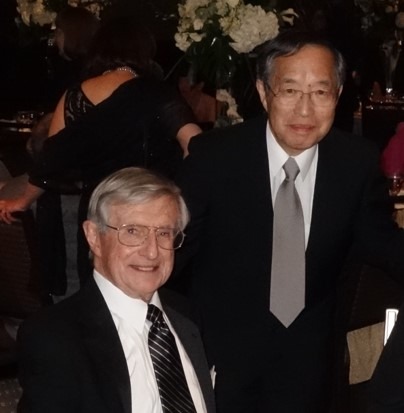
Drs. JJ Downes K. Miyasaka, 2016
In October 1994, he opened the first geographically distinct PICU in Japan at the National Children’s Hospital, the only one in Japan. He also founded the Japanese Society of Pediatric Intensive and Critical Care Medicine (JSPICC) in 1994.
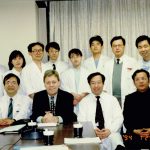
On the left. Physicians who contributed the opening of the first PICU in Japan in 1994 & on the right, PICU a few days after opening – 8 beds.
From left to right: Front row Drs. M. Takata. G. Barker, K. Miyasaka, M. Tamura. Back row Drs. T. Nakamura, Y. Imai, Y. Suzuki, Y. Ito, Y. Sakurai, H. Fujiwara, T, Kawano and H. Sakai
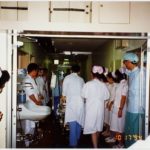
Just before the first patient arrived Oct 17, 1994
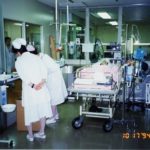
The first patient settled
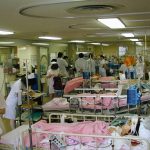
Few days after opening 8 beds
JSPICC hosted annual workshops to introduce state of the art information to the Japanese pediatric community, became a strong force in developing a close relationship with other Asian countries, and invited trainees from those countries to come to Japan to promote the teaching and development of pediatric critical care across Asia. JSPICC, as one of the few national organizations specialized in pediatric critical care in the 1990s, supported Dr. G.A. Barker to strengthen WFPICCS, including instituting the PCCM Journal. JSPICC recommended Dr. S. Iwai to be given posthumously a Gold Award for his contribution to pediatric critical care at the 3rd WFPICCS in Montreal, in 2000.
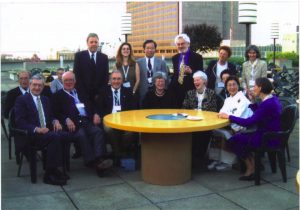
Ex-colleagues of the late Dr Iwai including their wives and Mrs Iwai at the WFPICC congress in Montreal in 2000 where Dr Iwai received a gold award for his contribution to PICU posthumously.
JSPICC strives to raise the recognition of pediatric critical care in Japan and one important development was the hosting of PALS training courses. The group proved to be an important resource to a Japanese governmental committee on pediatric brain death criteria with the help of Drs. G.A. Barker and A. Jarvis of HSC, Tex Kissoon of BC Children’s and Vinay Nadkarni of CHOP. JSPICC continued to foster the development of a new generation of pediatric intensivists and to play a major role in facilitating improved educational and structural guidelines.
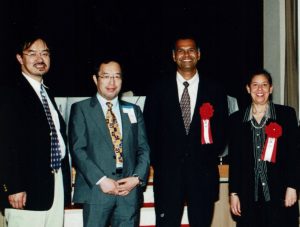
Drs. S Nakagawa, K. Miyasaka. Tex Kissoon, Anna Jarvis, 2004
Under the leadership of Dr. Hiro Sakai, a board member, and Ms. Akiko Ota, administrative assistant, extensive lobbying by JSPICC resulted in the establishment in 2002 of the National Center for Child Health and Development (NCCHD) in Tokyo from NCH. It became the national flagship children’s hospital, opening with a full PICU and ER. No children’s hospitals in Japan had PICUs, nor did they openly accept pediatric emergency cases until then.
JSPICC now has a membership of a little over 1000 and Japan now has 30 PICUs. Dr. Miyasaka was the president of JSPICC until 2012 when Dr. S. Nakagawa succeeded the position. JSPICC now has policies to promote exchange in Asia, transfer critical care technology to home care, and facilitate outcome research to substantiate the value of pediatric critical care.
